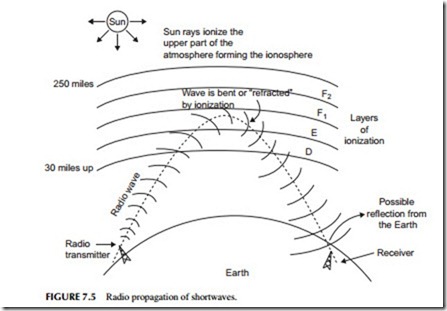RADIO WAVE PROPAGATION
Propagation refers to the way in which a radio signal travels from the transmit- ting antenna to the receiving antenna. The way the signal behaves is directly related to its frequency.
Low and Medium Frequencies
For example, in the low-frequency and medium-frequency ranges, the radio signals tend to hug the Earth as they move from transmitter to receiver. These ground wave signals can only travel relatively short distances because they are absorbed and attenuated by the Earth, trees, buildings, and other obstructions. Depending on the frequency of operation, transmitter power, and the nature of the terrain, distances are limited to several hundred miles. Distances can be extended with greater power or if the signal travels over water.
High Frequencies
In the HF or shortwave frequency range, the ground waves are extremely weak and travel only short distances, usually several miles. Instead, propagation is by way of refraction of the ionosphere. The ionosphere is an electrified area above the Earth located from approximately 30 miles to 250 miles above the Earth. The Sun ionizes the gases in the air, thereby giving them electrical characteristics. The closer the ionosphere to the Sun, the greater the degree the ionization. The ionosphere is actually several different layers or ionization levels as shown in Figure 7.5 . The upper layers have greater ionization than the lower layers. Obviously, the degree of ionization is determined by whether it is day or night. During the daylight hours, the ionosphere is highly charged electrically. At night, the ion layers essentially disappear.
A radio wave in the 3- to 30-MHz range is transmitted up to the ionosphere where it is refracted or bent by ionization. The degree of bending depends on the frequency of operation and how high in the ionosphere the radio wave penetrates. In most cases, the radio wave is bent so much that it actually returns to Earth. The effect appears to be similar to that of a light beam being reflected from a mirror.
As you can see, the radio wave actually returns to the Earth at some distance from the transmitter. Receiving stations in the area of the refracted signal can receive it. In some cases, if the signal is strong enough and the characteristics of the Earth are right, the radio signal may actually be reflected by the Earth back up to the ionosphere where it is again bent and returned to Earth. Under the right conditions, the radio signals can make several hops, thereby greatly extending the distance of communications. With the optimum frequency, power level, and time of day, communications halfway around the world can easily be achieved. That is why it is easy for you to listen to world- wide radio broadcasts that occur in the shortwave frequency bands.
VHF, UHF, and Microwaves
Radio wave propagation in the frequency range above 30 MHz occurs essentially by direct antenna-to-antenna space waves. This is usually called line- of-sight (LOS) communications. Further, the higher the frequency of the radio wave, the less it is affected by the ionosphere. UHF and microwave signals penetrate the ionosphere, making satellite and long-distance spacecraft communication possible.
LOS communications means that the transmitting antenna must be able to “see” the receiving antenna. If the distance of the receiving antenna is beyond the curvature of the Earth, the transmitted signal will simply pass over the antenna. To receive the signal, the receiving antenna or transmitting antenna can be increased in height, thereby extending the total range of communications. Figure 7.6 shows this idea. The simple formula along with it allows you to calculate the maximum LOS communications if you know the height of the receiving and transmitting antennas. That’s why at VHF, UHF, and microwave
frequencies, the height of the antenna is the most critical determining factor in overall communications distance.

